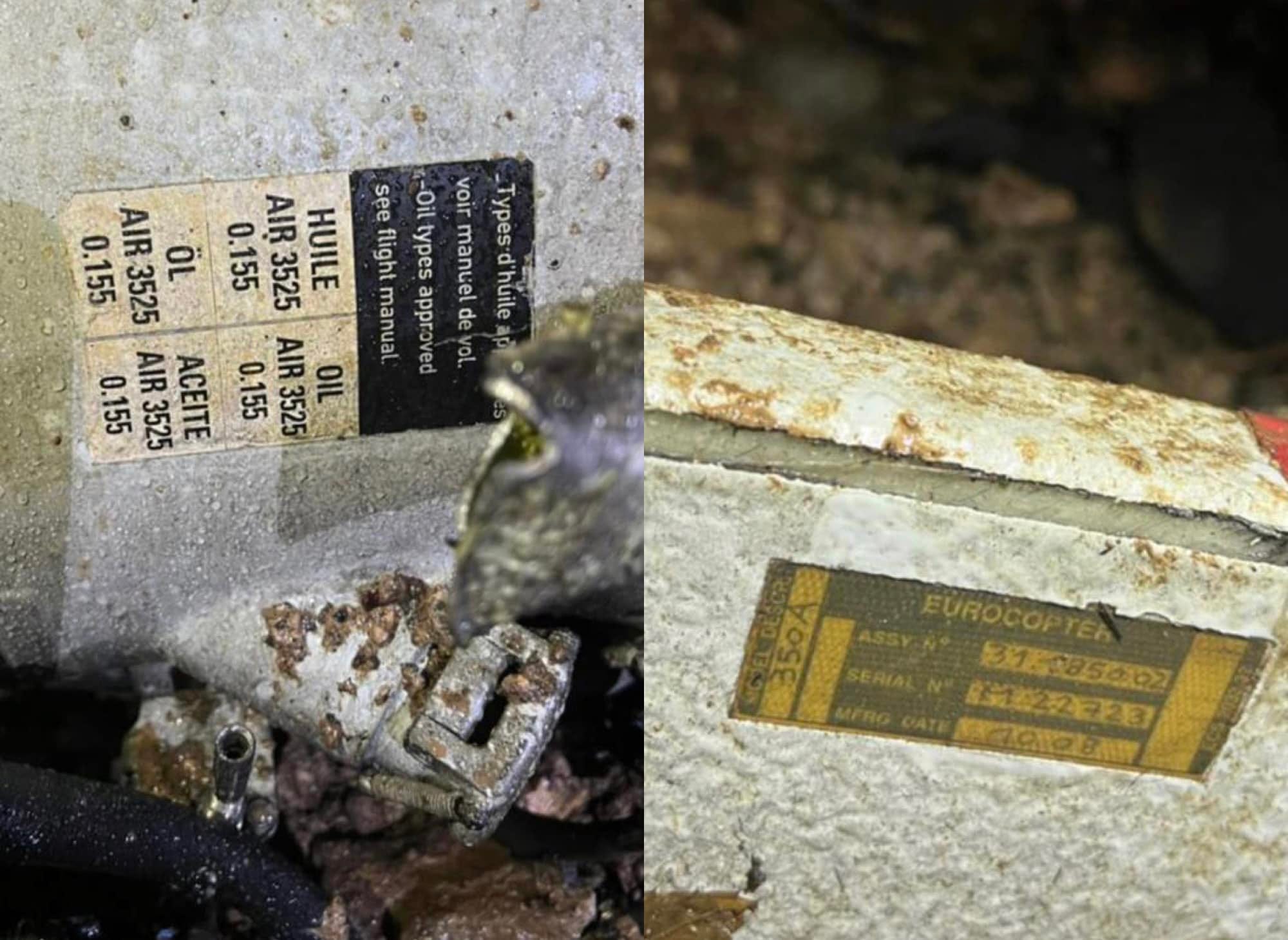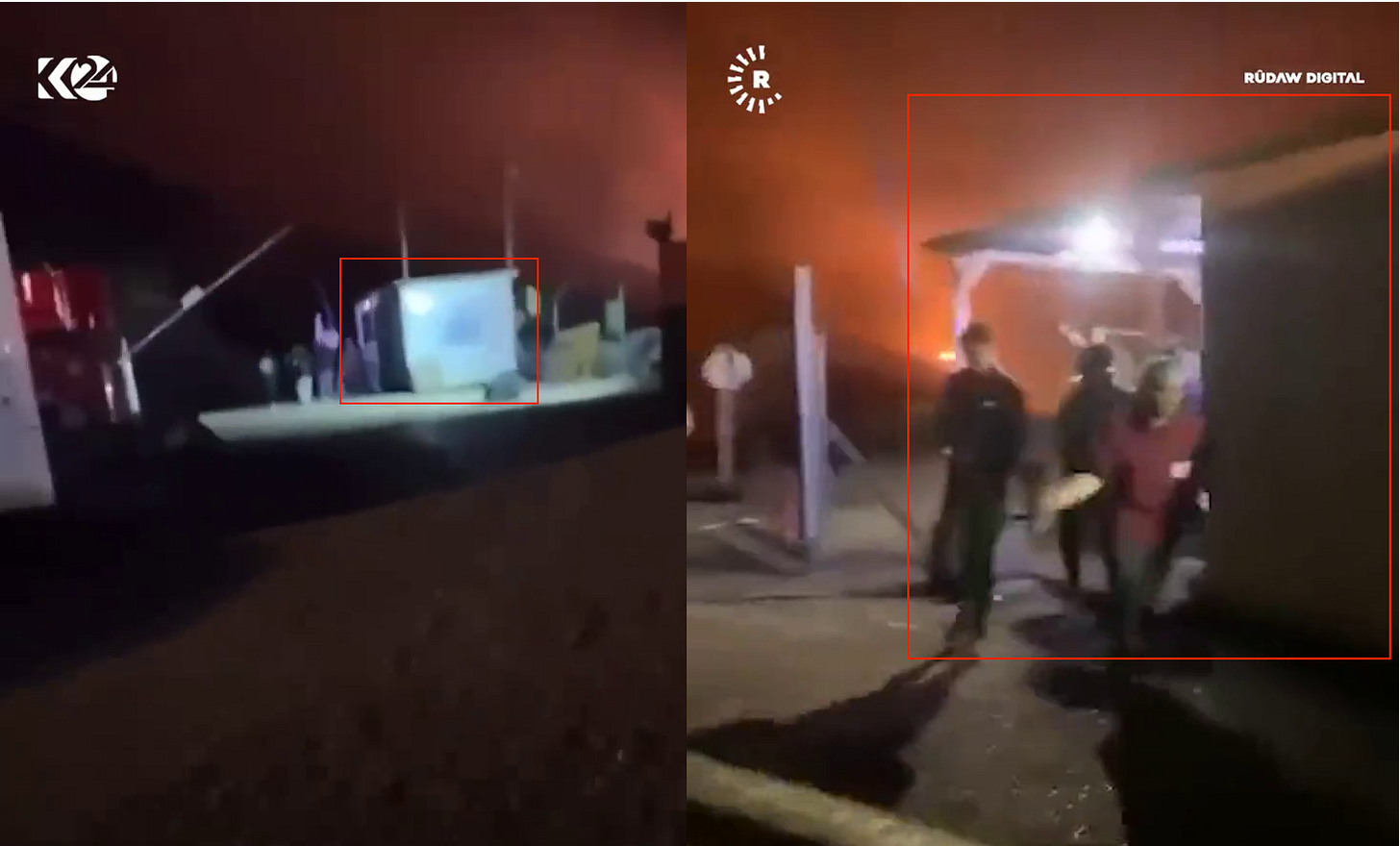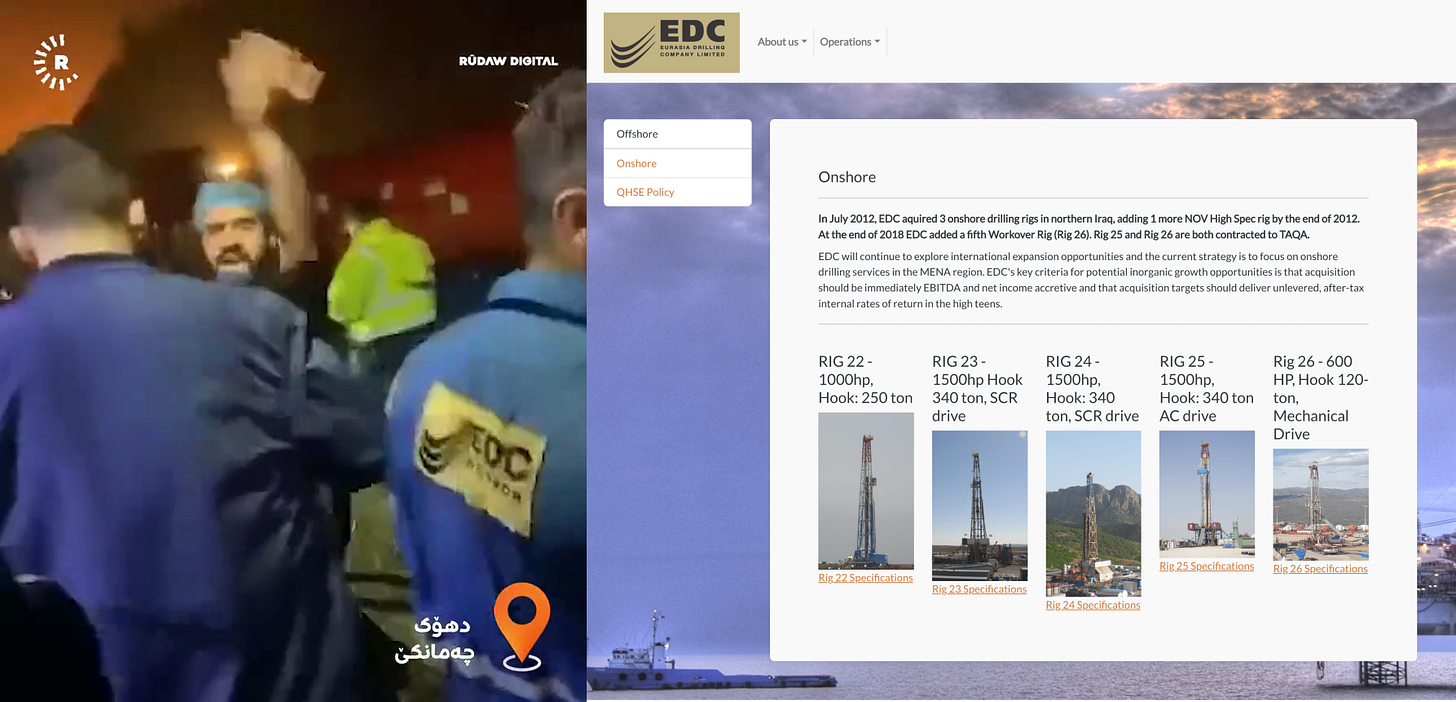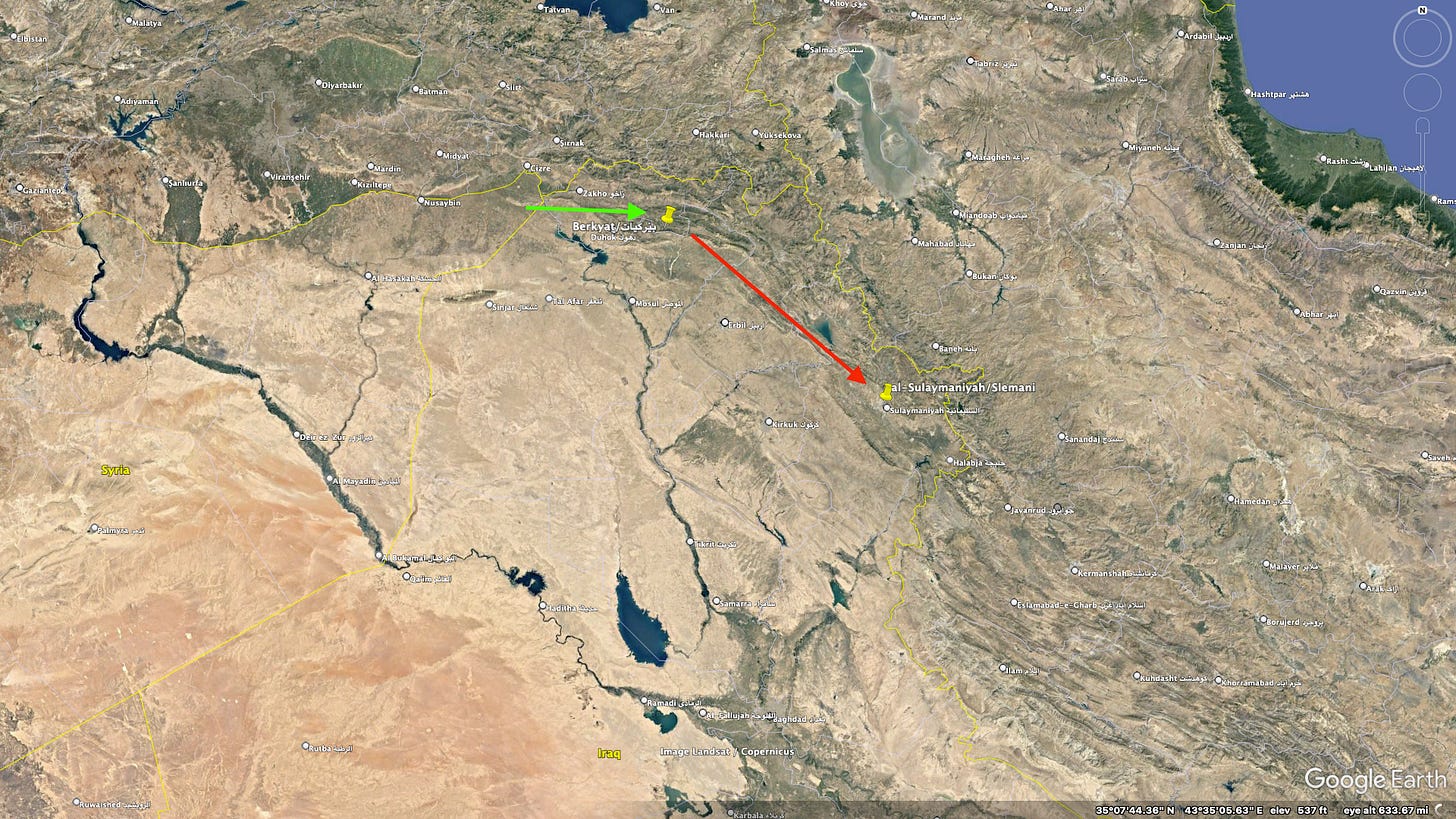On March 15th, a little before 9:30pm, reports of a helicopter crash in Iraqi Kurdistan’s (KRI) Duhok province began to appear on social media. This post will examine the openly available information regarding exactly what happened and outline the questions that remain.
Initial information:
The first official statement on the incident was published several hours later on Facebook by the Kurdistan Regional Government’s Directorate General of Counter Terrorism:
According to the KRG, the crash:
occurred at 8:40pm, near Berkyat (بێرکیات) village, Chamanke (چەمانکێ) district, Duhok province
involved one AS350 Eurocopter of unknown origin, carrying PKK members, all of whom died
The post also included an image of two photographs allegedly from the wreckage, corresponding with the claim above that the aircraft was an AS350 helicopter.
Location
The initial KRG statement said the crash took place near Berkyat (بێرکیات) village, in the Chamanke (چەمانکێ) district of Duhok province. Luckily, a mosque named Berkyat is marked on Google Maps [here], located under 10km southeast of the town of Chamanke (spelled جمانكي in Arabic).
Other relevant geographical information was provided in reporting by Rudaw published several hours after the news broke. According to Rudaw the crash occurred on the slopes of Mount Bekhere (چیای بێخێرێ), approximately 50m from an oil facility where employees witnessed the crash.
While the initial footage was taken at night soon after the crash, Rudaw published some video of the crash site a day and a half later allowing for relatively easy geolocation.



The oil facility mentioned by Rudaw appears to be one run by EDC Romfor, formerly the Romanian national drilling trust, now based in Cyprus and operating five drilling rigs in northern Iraq. The videos showing the fires of the crash site in the distance also show men wearing EDC jumpsuits. My guess is that this site is temporary housing for employees working on what I believe is ‘Rig 25’ (based on potential geolocation of a tiny image in a pdf), located up the road.
Identity of the victims
Two days later on March 17th, the SDF announced that nine members of its Counter Terrorism Units (YAT) had perished in the crash:
Within the framework and efforts to combat ISIS cells, a group of our SDF Counter-terrorism Units (YAT) headed to the south of the Kurdistan Region of Iraq to exchange security and military expertise that will help enhance the Units’ combat and security capacity in their ongoing tasks that are combating terrorism and protecting the region of NE Syria. While the two helicopters carrying our group of fighters were on their way to al-Sulaymaniyah city on the evening of March 15, 2023, they crashed due to bad weather conditions, leading to the martyrdom of nine of our fighters, including the commander of the YAT forces Shervan Kobani.

The city of Slemani/al-Sulaymaniyah is under control of the Patriotic Union of Kurdistan (PUK), the ‘second’ party of Iraqi Kurdistan after its rival, the ruling Kurdistan Democratic Party (KDP). While the PUK has historically maintained friendly ties with the Apoçi movement and was reportedly responsible for facilitating the YPG/SDF relationship with the United States in 2014, this relationship was symbolically upgraded in December, with PUK President Bafel Talabani’s December visit to northeastern Syria.
Following the crash, Bafel Talabani offered his condolences to the SDF and head of the PUK-founded Counter-Terrorism Group Wahab Halabjay attended the funeral for the nine victims held in al-Hasakah city on March 22nd.
A later statement by the KRG’s Regional Security Council repeated the SDF claim that the intended flight path was from Syria to Slemani, but continued to refer to the crashed helicopter in the singular. The Security Council statement also said that the proper authorities in the KRI had not been informed and demanded answers from the International Coalition and the Iraqi federal government. Later that day, Kurdistan 24, a news network close to the ruling KDP reported that two bodies (seven were initially reported) and a second helicopter crash had been discovered near Berkyat, though as far as I can tell the KRG has yet to publicly disclose this.
The helicopter(s)
So far there is no reason to doubt the claim by the Directorate General of Counter Terrorism that the aircraft(s) was a Eurocopter AS350, a popular French-made civilian and military-use helicopter in operation around the world since 1975. The only visual evidence that could possibly identify the specific aircrafts and their ownership are the two photos published on March 15th.

The labels visible in the two photographs read:
oil: AIR 3525 0.155
model descrp: 350A
assy no: 31 []85002
serial no: []1 22723
mfrc date: []0 08
Disclaimer: I know nothing about helicopters (or any kind of motor vehicle for that matter, I grew up in Brooklyn)
The 350A ‘model description’ on the label in the picture to the right doesn’t actually correspond with any existing AS350 variant. Additionally, the AS350 appears to use four digit serial numbers, rather than the XX XXXXX see in the photo. For these reasons I believe the photo on the right belongs to a component rather than the aircraft itself. A xeroxed flight manual available online does show that the AS350 B3 variant does use AIR 3525/0.155 mineral base oil in its lubrication systems.
According to statements made by KRI Prime Minister Masrour Barzani on March 18th, the helicopter belong to the PUK. The PUK-founded Counter-Terrorism Group (CTG) operated AS350 B3s in the past, with two registered under the names “Tiger 01” and “Tiger 02” (though apparently by 2020 registered with the Iraqi YI-XXX codes).


Conclusion
The most recent statements given by representatives SDF, the KDP, and the PUK appear to tell one general story. On the night of May 15th 2023, nine members of the SDF’s elite YAT branch traveled by helicopter from Syria in an indirect path towards the PUK-controlled city of Slemani/al-Sulaymaniyah. The objective of their trip was ostensibly to undergo joint training with adjacent units from the PUK’s security services. These joint training exercises, headed byS DF commander-in-chief Mazloum Kobani’s nephew Sherwan, would likely have much greater political significance than tactical benefit: further strengthening the SDF-PUK relationship in the wake of Bafel Talabani’s unprecedented December cross-border visit.
Given the immense antagonism between both the SDF and the PUK, the KDP-aligned security bureau of the KRI was not alerted to the itinerary. Instead, the two helicopters took off at dark and flew low, seemingly succumbing to the poor weather and treacherous terrain of winter-time Kurdistan approximately a third of the way through their trip.
The primary questions that remain are whose helicopters were these and who was piloting them? By process of elimination along with the statement by Masrour Barzani it appears likely the helicopters were owned by the PUK, but we still lack hard evidence - actually identifying individual aircraft - and don’t know whether these came from the preexisting CTG fleet. And who were the pilots? Were individuals from Syria recently trained by [?] to fly AS350s? Or did two PUK pilots anonymously perish in the crash? And when did the helicopters arrive in Syria to begin with?
If you have further insight into the apparent AS350 label allegedly seen in the wreckage, please reach out
Update (April 12 2023): Citing a private source, SyriaTV claimed that the helicopter pilots were members of the SDF. These individuals allegedly underwent Coalition training “years ago” in addition to more recent participation in courses provided by the PUK’s CTG in Iraqi Kurdistan. The pieces additionally alleges that the SDF had recently acquired the two AS 350s, adding to a supposed pre-existing fleet of an unknown size, consisting of two-seater civilian aircraft. Interesting claims, but more evidence is required to substantiate them.









